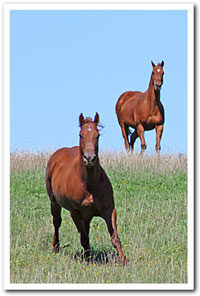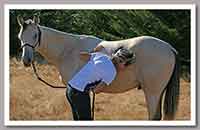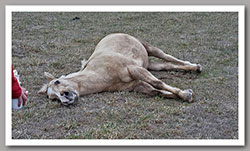Grass Tetany and Colic 
I now believe various degrees of grass tetany is the fundamental root cause of most of the health and behavioural issues with our horses.
Because the symptoms are so wide and varied it has taken a long time to put two and two together.
The cool, cloudy, wet weather of spring and autumn (including frosts and freezes) cause acute spikes of potassium and nitrate in the grasses our horses are eating.
This grass may only be 1cm long, but under these climatic conditions it can have a drastic effect on your horse...
Overview

This effect can be made worse by high protein feeds, as protein converts to nitrate which has to be somehow eliminated at the expense of your horses calcium and magnesium supply.
Fertilised Rye Grass and Clover are the worst for this scenario but ANY grasses under the 'right' conditions can have the same effect. This is why it is so important to have somewhere you can keep your horse completely OFF the grass during these times (early spring, autumn to early winter and drought breaking rains).
All the literature I have read says that horses don't suffer from nitrate toxicity like other stock. Indeed I have a copy of a letter from a prominent Canterbury vet who says that there is no evidence that horses suffer from grass tetany at all! He couldn't be further wrong!
As the following paragraphs explain, it is not the nitrate directly but the fact that it enters the system as potassium nitrate. The excess potassium and toxic nitrate is excreted by latching onto calcium and magnesium indirectly, causing a serious deficiency of these vital minerals and all the associated health and behaviour issues (an extensive list!).
Dr. Swerczek
For those who need a more scientific explanation, whilst the article refers mainly to cattle, Dr. Swerczek has since done trials on horses which prove they are affected by the same process. Grass, even if it is very short, can be dangerous under certain conditions which include a drought breaking rain.
You can read Dr. Swerczek's brilliant article, Don't Short Salt.
Nitrate Toxicity, Sodium Deficiency and the Grass Tetany Syndrome
The following are excerpts from
"Nitrate Toxicity, Sodium Deficiency and the Grass Tetany Syndrome" by Dr. Swerczek, DVM, Ph.D.
Numerous researchers have found that grass tetany occurs most often in older brood cows grazing lush growth of pastures in early spring. The triggering of the grass tetany syndrome includes environmental conditions of cool, cloudy and wet weather, promoting rapid, lush growth of cool season grasses. These environmental conditions, which also include frosts and freezes, will cause acute spikes in potassium as well as nitrate in affected growing pastures. Analysis of these affected pastures during and after periods of frosts and freezes revealed elevated levels of potassium and nitrate.
Nitrate in the form of potassium nitrate is reportedly the form which herbivores are exposed to nitrate. During periods of stress to pastures forages, the acute spike in potassium and nitrate is seemingly causing an electrolyte and mineral imbalance in affected herbivores.
If nitrate is excessive, a hypomagnesia (magnesium deficiency) and/or hypocalcaemia (calcium deficiency) may develop as the body is eliminating magnesium and calcium with the excessive anionic nitrate. However, if there is adequate sodium in the diet, organs and tissues, the excessive anionic nitrate is removed by the gut, kidneys and mammary glands in lactating animals, as a ionic complex associated with sodium, magnesium and calcium are maintained at physiologic levels and hypomagnesia and/or hypocalcaemia will not occur.
For this reason adequate levels of sodium in the body and ration will lessen or prevent the drastic effects of nitrate toxicity. Also, it explains why adequate sodium in the diet will aid in the prevention of grass tetany, which is associated with high potassium and low magnesium level
What exactly is Grass Tetany?
“Grazing is the meeting of animal and grass. This can be happy or unhappy,it may even be tragic, as in the case of grass tetany (Andre Voisin)”
Typical Symptoms of Grass Tetany:
- Muscle stiffness, high muscle tonus, contractions of the tail (tail clamping).
- Mouth closed and difficult to open; grinding of teeth
- Eyes wild, blood-shot eyes, frequently rolling. (hence confusion with ‘colic’)
- Head thrown back.
- Sensitivity much greater
- Pulse feeble and much more rapid.
- Hyper-irritability
So you can see that Grass Tetany is right at the extreme end of ‘Grass-Affectedness’!!
Many ‘grass-affected’ horses show mild to moderate versions of these symptoms that many of you recognise. Becoming ‘stiff’ in their gait is a very common first sign of trouble.
The occurrence of full blown Grass Tetany is usually the result of a ‘perfect storm’ scenario. Predisposing factors include
Grass which is ‘new’, or too rich and lush, too short and stressed, or fertilised with potash, NPK, super, urea
- Such grass tends to be far too high in potassium at the same time as being low in sodium and magnesium which typically happens in spring and Autumn (one Forage test we conducted of grass from a horse that was repeatedly ‘colicking’ early spring last year had a potassium:sodium ratio of 54, this is really high)
- Far too high in Crude Protein or nitrates (that same grass had a very high CP content at 35%)
Grazed by livestock that have a less than optimal nutritional history since CONCEPTION
ie: have been exposed repeatedly or chronically to this sort of ‘tetanic herbage’(like dairy pasture) to the point their self-regulating mechanisms involving various glands and hormones, are not functioning properly (only livestock whose kidneys and adrenal glands are in perfect working order can temporarily handle such ‘tetanic herbage’).
- And have not been supplemented with salt & magnesium, in other words they are already depleted because of insufficient supplementation over winter and are often down in condition
The horse in the story below was young (only 2 years old), had been turned out all winter on a hill paddock.
The moral of the story is : keep ALL your horses well nourished by going to the trouble of mixing a small feed every day (all of you guys will be already doing this!) the purpose of which is to make sure they get these vital minerals and vitamins with their SALT.
To see a horse suffering from this is an experience you want to avoid at all costs.
Is it ‘Atypical Myopathy’ or just plain ‘Grass Tetany’?
It is very sad to hear of so many horses suffering and even dying of ‘Atypical Myopathy’ when it could just as well be ‘Grass Tetany’ which is relatively easy to treat with salt and other electrolytes (no potassium) .
Based on our experience with horses showing these very same symptoms there is nothing to lose by treating them as for ‘Grass Tetany’.
Gut Noises & Colic ...
With the onset of Autumn come seasonal and weather related changes in the pasture grass leading to an increase in the incidence of certain equine ‘colics’.
While the days are still warm, the night-time temperatures are dropping and these factors, along with the Autumn rain, alter the chemical composition of the grass which can result in colic in some horses. (Not to mention laminitis, head-flicking and behavioural problems!)
The trouble is there are numerous causes of ‘abdominal pain’ or ‘colic’. Because some of them are life-threatening always call your veterinarian immediately should you observe any of the following signs:
Pawing, rolling, looking around or kicking at the abdomen, bloating, sweating, distress, uneasiness, agitation, loss of interest in food and water, unusual postures like sitting or standing stretched out, louder than normal gut noises or the absence of gut noises.
The last two are significant. At a time you know your horse is well, familiarise yourself with his normal gut sounds by standing at his side keeping his head bent slightly around towards you. Place your ear against his flank just behind the ribs. You will hear a variety of gurgly, rumbly sounds. These are the normal sounds of the digestion process.

Check both sides.
The following are two types of colic that can be associated with the change in season:
Gas colic
Sometimes gas builds up in the intestine, most commonly in the large intestine and/or caecum. The gas stretches the intestine, causing discomfort and pain. You will hear louder and gurglier than normal gut noises sometimesgt audible from a few metres!.
Spasmodic recurring colic
Some cases of colic are due to increased intestinal contractions, the abnormal spasms causing the intestines to contract painfully. These tend to come and go and some horses suffer multiple bouts.
These ‘colics’ often coincide with changes in the grass of spring & autumn. Gas colics are characterised by gut noises that are louder and gurglier than normal. Forage tests taken from pasture consumed by horses suffering repeated bouts of such colic revealed very high potassium:sodium ratios (for example 54, when it should be no higher than 5)
CALL YOUR VETERINARIAN (Don’t delay with any colic)
Some diet changes may be necessary to prevent further bouts.
What you don’t want to hear when listening for gut noises is no sounds!
Barely audible or absent gut noises suggest a life-threatening impaction or twist in the horse’s intestine. Be clear this is a REAL EMERGENCY and needs URGENT veterinary intervention.
Nitrate Toxicity...
It is apparent that nitrate toxicity in herbivores is much more prevalent than previously reported. A well documented form of nitrate toxicity occurs in ruminants when nitrate is converted to nitrite by the microflora of the gastrointestinal tract and then the nitrite induces a methemoglobinemia and anoxia.
However, it is hypothesised that a much more common mode of nitrate toxicity, and previously not recognised, is when nitrate toxicity induces a severe electrolyte and mineral imbalance in ruminant and non-ruminant herbivores. This form of nitrate toxicity is an important factor in the pathogenesis of the grass tetany syndrome and likely other syndromes in herbivores, including reproductive disorders in all herbivores, including horses.
Seemingly, adequate dietary sodium not only protects against nitrate toxicity, but also aids in the prevention of the grass tetany syndrome in herbivores and other metabolic and reproductive disorders induced by nitrate in herbivores.
The high nitrate in the milk may also explain why neonates seemingly are affected with a multitude of opportunistic gastrointestinal diseases, including gastric ulcers and other intestinal disorders. Conversely, dams fed a low protein diet and adequate sodium rarely have neonates suffering from these gastrointestinal disorders.
Potassium promotes the overgrowth of saprotrophic (micro-organisms that normally grow on dead matter), commensal (organisms that live together but don't harm each other) and pathogenic (microbes that cause disease) micro-organisms in plants, especially plants damaged by droughts, frosts and freezes. Thus, such forages become the source of many opportunistic, potentially pathogenic bacteria and fungi.
After ingesting them, livestock face an overgrowth of opportunistic, pathogenic organisms in the gut. The organisms rapidly proliferate to produce toxic by-products, like excessive ammonia, which is acutely toxic to foetuses and the immune system.
These pathogens infect not only the foraging animals but their foetuses. Early and mid-term foetuses may abort, while near-term foetuses may suffer premature birth, and/or septic weak neonatal birth. Similarly, it's felt that high-potassium forages encourage excessive growth of endophytic and other pathogenic fungi, especially in Fescue and Rye Grasses. The toxins these fungi produce add to the reproductive problems in cattle and horses.
Recumbency or Inability to Stand

This is not common but can happen especially with the changes in the grass associated with Spring & Autumn so it pays to be aware. The horse ‘flops’ on the ground and lays down flat as in the photo. This horse had been eating the fresh Autumn growth in a yard while waiting for the hoof trimmer.
Note this is not colic, there are no signs of abdominal discomfort and no loud gut noises. No thrashing or attempting to roll when down. It is caused by a disturbance to calcium metabolism not unlike that which farmers experience with their cows in spring.
Note: If it was the much more serious ‘tetany’ the legs would be rigid with intermittent ‘paddling’ due to severe cramping. This is excrutiatingly painful and a metabolic emergency. It requires urgent veterinary intervention.
The symptoms of ‘Atypical Myopathy’:
Most frequently reported clinical signs include the
· sudden, unexplained onset of muscle stiffness,
· weakness,
· altered gait,
· rapid heart rate,
· laboured breathing,
· sweating,
· bladder distension,
· blood in the urine,
· muscle twitches.
· Horses lying down may be unable to get up again.
 Calm Healthy Horses
Calm Healthy Horses